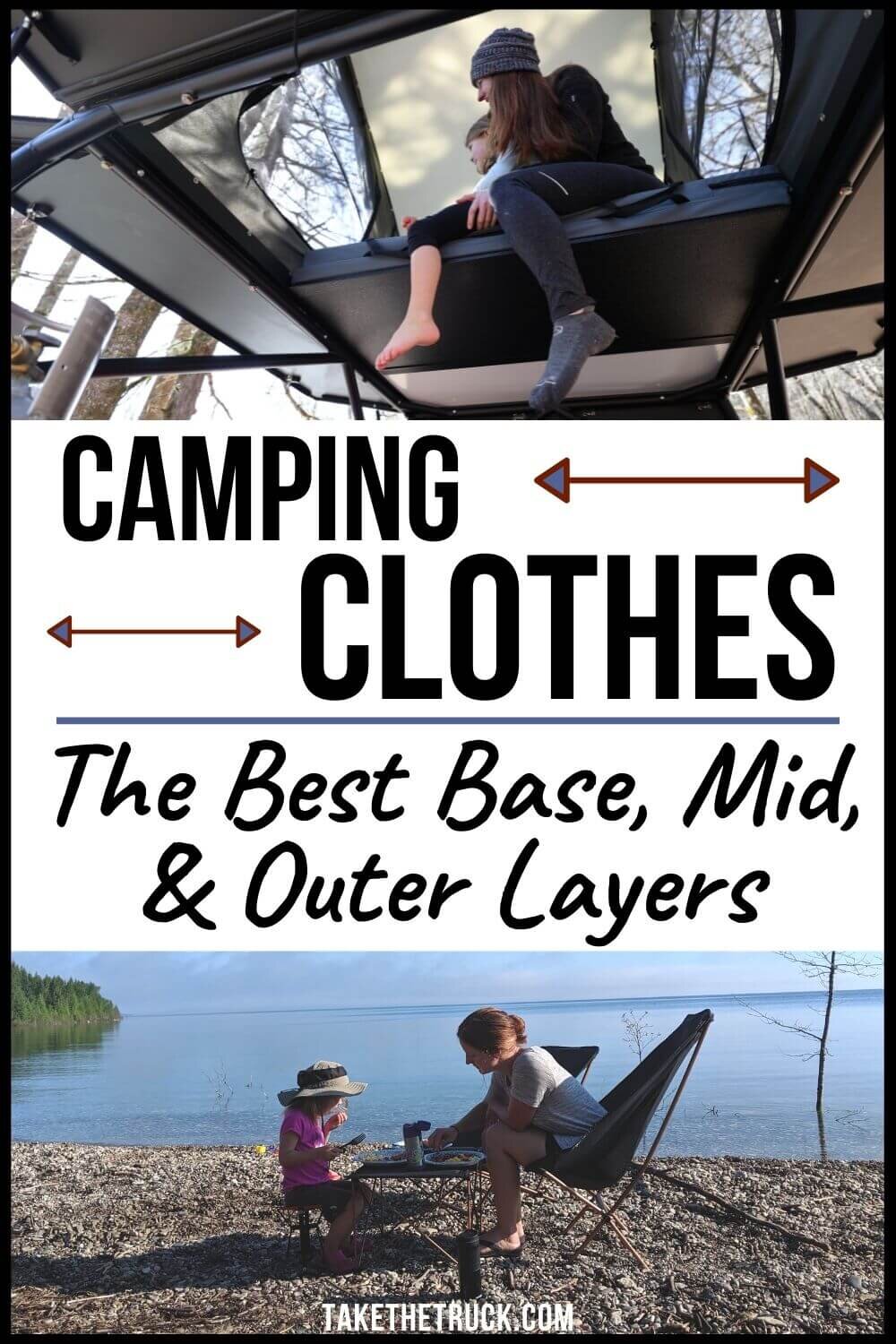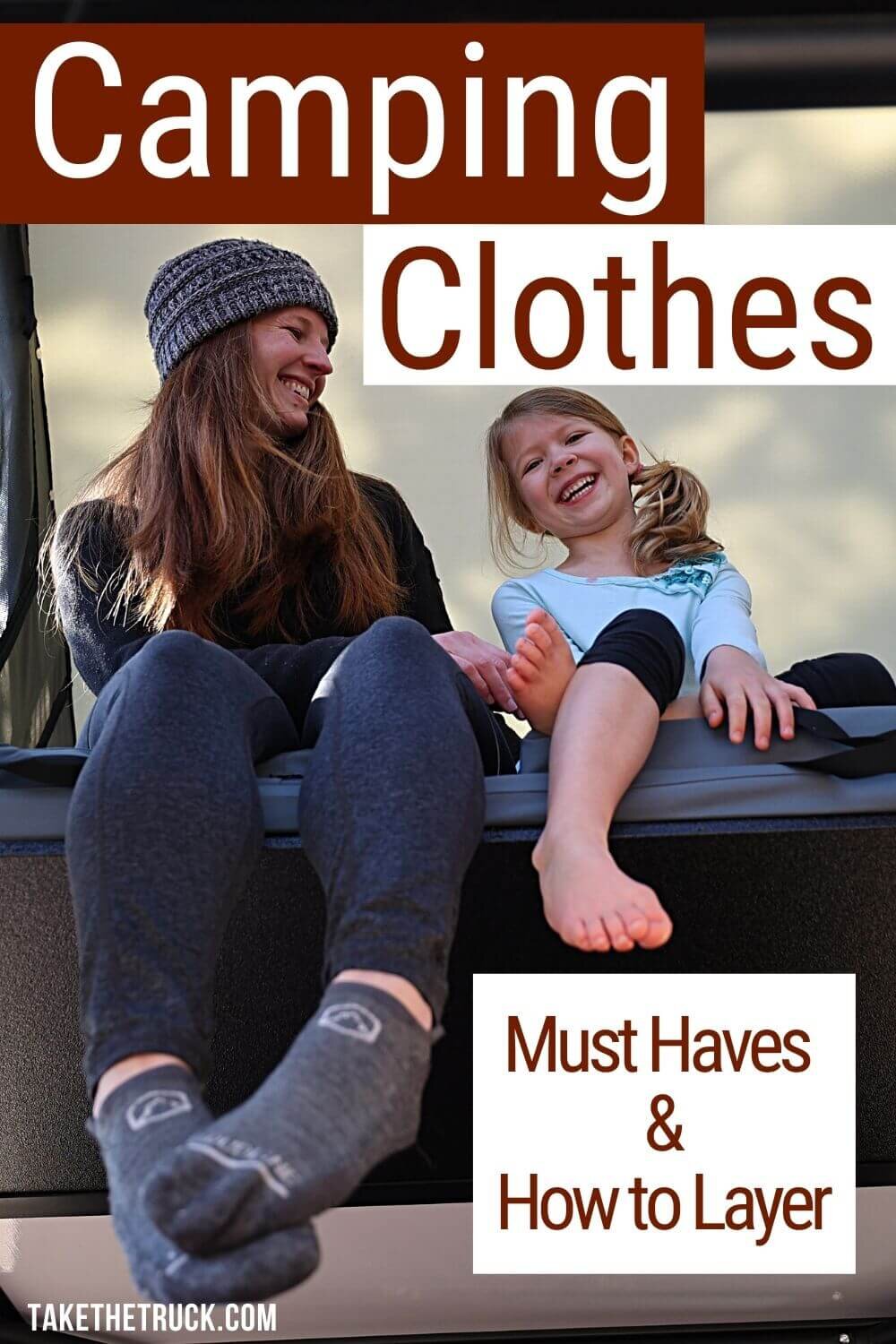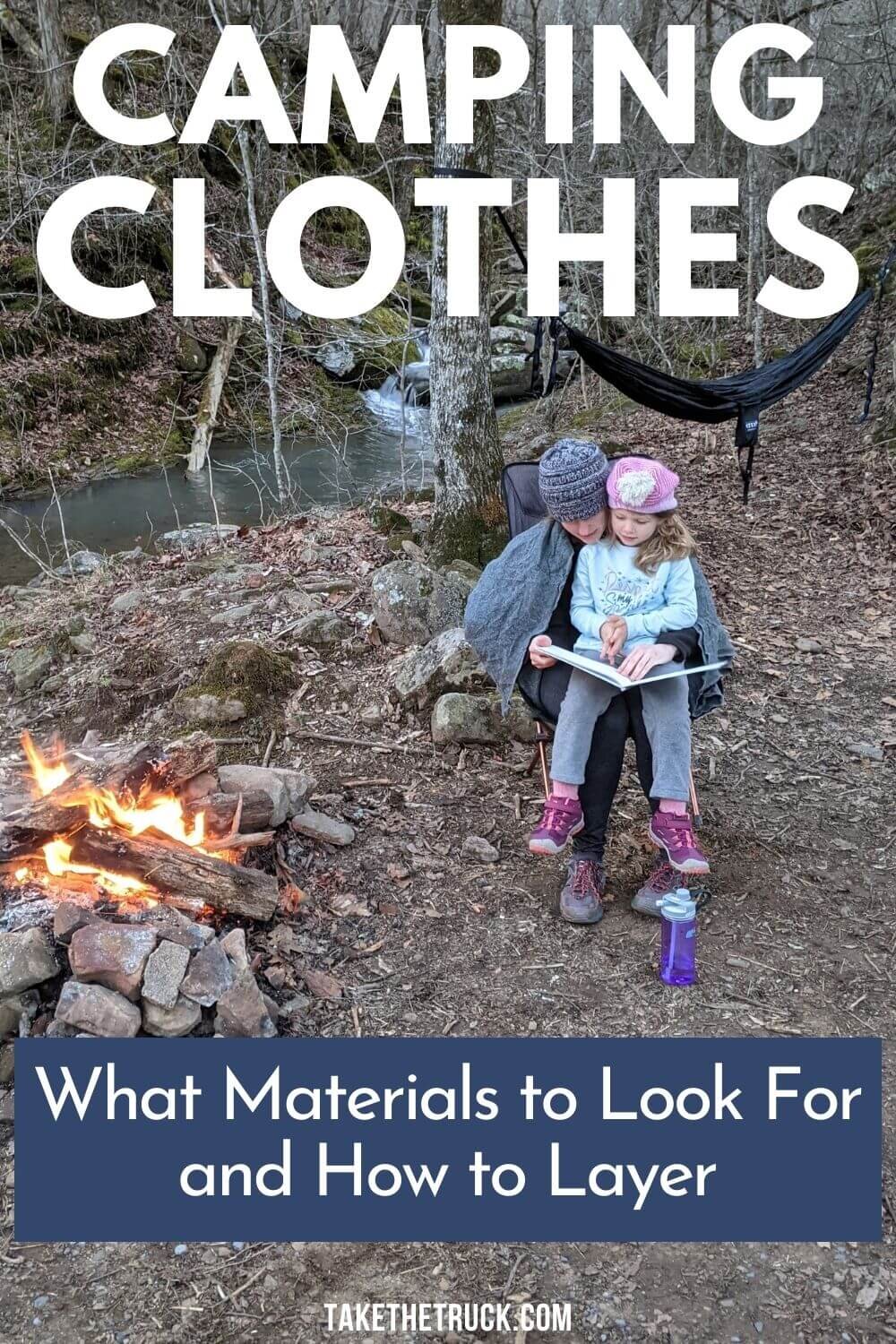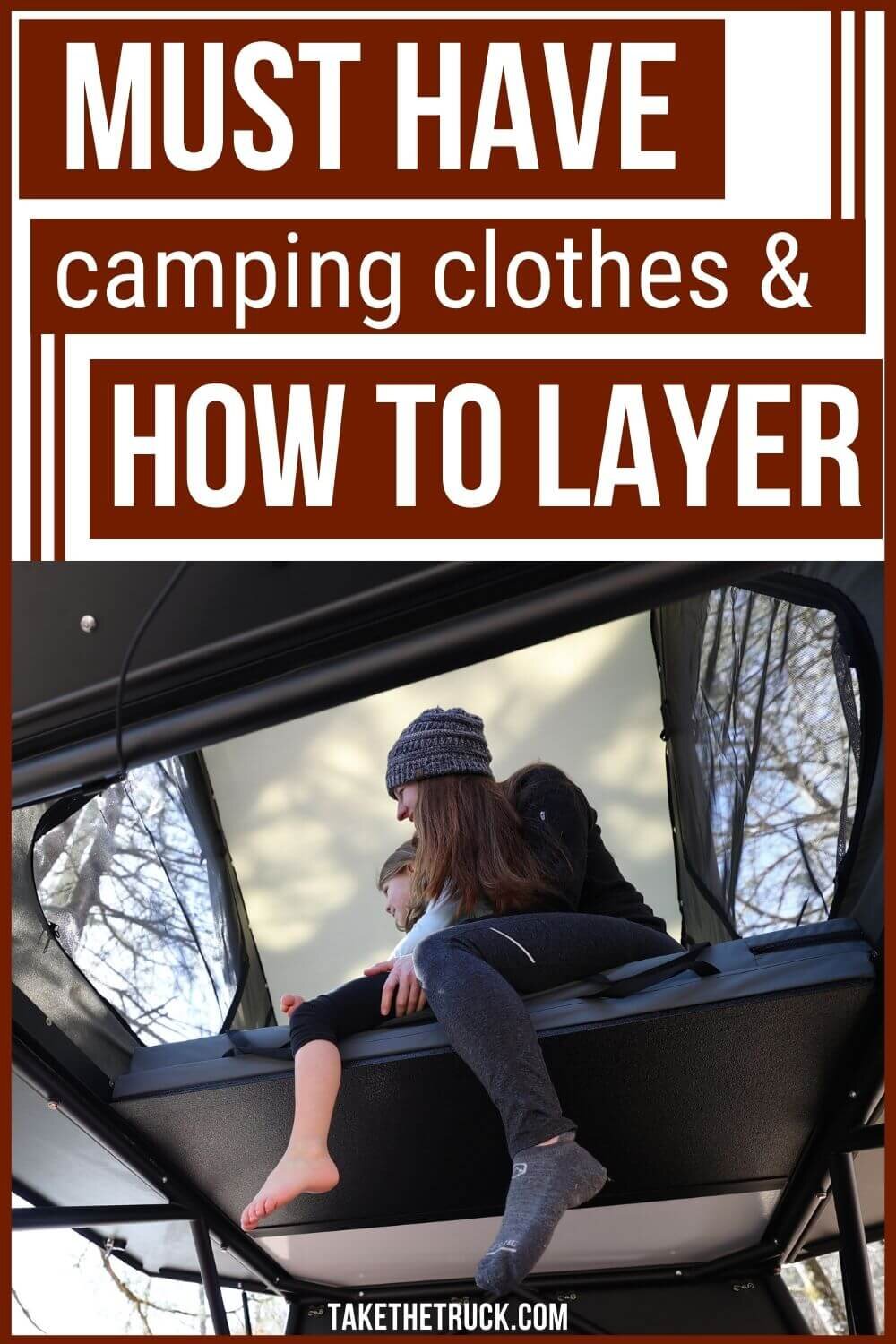Super Simple Guide for What to Wear Camping
Knowing what to wear when camping can be challenging. Weather conditions, humidity, and temperature all factor into the process of selecting camping outfits that are both comfortable and effective at protecting you from the elements.
In this guide we’ll discuss outdoor clothing fabrics, strategies for layering your camping outfits so you're prepared for a variety of conditions, how to choose what to wear on your next camping adventure, a few specific outdoor clothing brands we recommend, and some tips to make packing as stress-free as possible.
*(This post contains affiliate links. This means we may receive a small commission, at no additional cost to you, if you make a purchase through a link. See our full disclosure.)
Camping Outfit Strategies
Layering: By strategically layering the clothing that makes up your camping outfit you’re able to add or subtract those layers to adapt to changing temperatures or weather conditions. We’ll dive into this in greater detail below!
Avoid Cotton and Denim: Cotton retains moisture which can make camping in summer heat miserable by trapping moisture/sweat against your body, and provides little value in the way of insulating while cold weather camping.
Always Check Weather Conditions, and Be Prepared: Your safety and protection from the elements is largely dependent on the clothing you pack while camping. Forecasts are rarely 100% accurate, so be prepared for conditions to change unexpectedly and pack camping outfits for multiple temps and conditions.
Function over Fashion: Most people go camping to avoid human contact and immerse themselves in the beauty of nature, so your camping outfit doesn’t need to be fashionable. When you’re selecting camping clothing, make comfort, durability, weight, and price your primary criteria.
The Two Pair Shoe Challenge: Footwear is likely one of the most important (and challenging) components of an effective camping outfit. Invest in a high quality pair of supportive hiking boots or trail shoes, and multi-purpose sandals before any other camping-specific clothing - your feet, ankles, knees, and back will thank you, if not now, when you’re older!
Fabric Properties of Camping Clothes
Wicking: Wicking refers to a fabric’s ability to draw moisture and/or sweat away from your skin and move it to the fabric’s outer surface, where it can dry quickly. This is important to look for in a base layer, or any other camping clothing that touches your skin.
Waterproof / Windproof: This fabric property keeps your camping clothes from becoming saturated by the rain or snow, and prevents body heat loss in windy conditions.
Note that water and wind “resistant” fabrics do not fully block rain/snow and wind. And fabrics that are waterproof may not expressly state that they’re windproof, even though they would be due to the inherent properties of waterproof fabrics.
Breathability: Having breathable fabrics in all of your camping outfit layers helps your base layer wick moisture away from your skin more effectively and dry out quickly. If your mid-layer and outer layer are not breathable, perspiration being wicked off your skin by your base layer won’t dry effectively and you can end up drenched in sweat.
Insulating: Clothing fabric that is efficient at retaining your body heat close to your base layer is considered insulating, and is what you want to look for in mid-layer camping outfits.
UV Protection: Camping outfits that include an ultraviolet protection factor (UPF) rating will help keep your skin protected from the sun’s damaging UV rays. When worn in conjunction with a quality sunscreen, you can enjoy your time in the sun with less concern of getting sunburned.
Specific Camping Outfit Materials
Wool: Modern wool clothing is not the scratchy, irritating, camp clothing material it once was. Merino wool fabrics use ultra fine fibers that make it soft, moisture-wicking, breathable, and fairly fast drying. Wool also doesn’t retain body odor nearly as much as cotton or non-treated synthetics, which is certainly great for anyone who’s camping with you!
Synthetics: Typically more budget-friendly than merino wool, synthetic clothing materials like polyester and nylon have excellent wicking properties, they insulate better than cotton, and dry fast too. The biggest caveat of synthetic clothing material is that it retains body odor, so be sure to look for synthetic camping outfits that have an antimicrobial treatment which helps to neutralize odor-causing bacteria.
Fleece: Fleece is a type of thick fibrous polyester material that retains heat well at a fraction of the cost of merino wool alternatives.
High-tech Synthetics: Woven synthetic fabrics are often used in combination with special coatings or laminates to create rain and wind resistant clothing. Materials such as GOR-TEX, e-Vent, and others utilize more advanced material science to allow for increased breathability as well.
Cotton: While we already touched on the fact that cotton should generally be avoided for it’s notably inefficient insulating, wicking, and drying properties, cotton does have its place in certain circumstances. It’s excellent at soaking up sweat and water which can help to cool you through evaporation in more arid climates, or it can be useful for keeping the sweat out of your eyes when used as a bandana.
But in cold weather this same moisture retention can quickly draw heat away from your skin, increasing the risk of hypothermia, hence the old saying amongst seasoned cold weather campers: “cotton kills.”
How to Layer Your Camping Clothes
Having a good strategy for layering your camping clothes will help you easily adjust your clothing to changing temperatures and weather conditions while your camping. And while some of these clothes can be pricey, investing in a few quality layers will ultimately allow you to be more comfortable and pack fewer clothes for camping trips.
Base Layer Camping Clothes
The base layer is the layer of clothing that’s right against your skin. You want this layer to both insulate and wick away moisture. Your base layer consists of items like socks, underwear, bras, and/or insulating long johns.
Underwear: Select the style of underwear that you typically wear and that is most comfortable to you. Stick to polyester or nylon underwear with an antimicrobial treatment (to reduce body odor retention), or merino wool underwear that have natural antimicrobial properties, and avoid cotton. You’ll want to purposefully select underwear with a supportive fit that are non-chafing.
Our Favorite Camping Underwear:
Exofficio* (anti-microbial synthetic)
Icebreaker* (merino wool)
Socks: Often overlooked, socks are equally as important as your footwear while camping. The socks you choose need to be taller than your hiking boots or trail shoes, and again merino wool is the best fabric option because of its natural antimicrobial properties keeping odor at bay and its wicking ability helping to keep your feet dry.
We routinely get a couple days use out of one pair of socks while camping. It’s a good idea to pack both thicker and thinner pairs so you can adjust based on the weather conditions or activities you're doing.
Our Favorite Camping Socks:
Bras: Finding a good bra for camping can be challenging, but try to select a sports bra that is fitted accurately to your size while still being comfortable, and make sure the level of support it provides matches the intensity of your activity (e.g. hiking vs climbing vs just lounging around camp, etc.). Just as with all of your base layer items, try to find a quality camping sports bra that’s made with merino wool or synthetic material.
Our Favorite Camping Bras:
Smartwool Bras* (merino wool)
The North Face Bras* (synthetic)
Insulated Base Layer (Long Johns / Long Underwear): Insulating base layers are available in lightweight, midweight, and heavyweight fabrics so you can select a weight based on the temperatures you anticipate camping in. They’re great for additional warmth while sleeping in colder temps.
Plus the insulated bottoms can be worn under shorts to provide additional warmth and/or UV protection as needed throughout the day. You can also wear them under primary mid layer pants when temperatures drop.
Our Favorite Insulated Base Layers:
Base Layer Tops:
Merino.tech* (merino wool)
Icebreaker* (merino wool)
Base Layer Bottoms:
Merino.tech* (merino wool)
Icebreaker* (merino wool)
**Don’t forget to take into consideration your personal metabolism (whether you naturally run “warm” or “cold blooded”) when selecting a fabric weight, those that naturally run warmer may find a lightweight set of Long Johns is comfortable at a given temp, while a “cold-blooded” person may need a heavyweight pair for the same conditions.
PRO TIP: Not only will you get more mileage out of these higher quality base layers, you can use the Scrubba Wash Bag to wash your base layer clothes quickly and easily at camp - allowing you to pack fewer clothes on longer camping trips too.
Mid Layer Camping Clothes
This layer is usually broken into two categories: Primary Mid-Layer and Secondary Mid-Layer
Primary Mid Layer
The Primary Mid Layer is the layer just outside of your Base Layer. These are the clothes you’ll wear most often while camping in moderate climates and temperatures, and you’ll want to ensure they’re as comfortable as they are durable.
Shirts: Synthetic or merino wool short-sleeve or long-sleeve T-shirts, tank tops, or camisoles that wick moisture away from your skin are great for warm weather camping, and merino wool long-sleeve tops are excellent for providing warmth in cooler temps.
A long-sleeve UV protective shirt is also good for protecting your skin during hiking or other activities in direct sunlight.
Our Favorite Camping Shirts:
Merino.tech* - budget-friendly wool shirts & tops
Icebreaker* - high quality wool shirts & tops
Shorts, Pants, and Convertible Pants: While convertible (zip-off) pants get pretty low fashion points, they’re highly versatile for camping and save room while packing.
Quick-dry fabrics are a must - not only does it make doing laundry while camping easier and aid in wicking and evaporating sweat, but some fast dry shorts can also double as swimwear, again saving space (and money).
Look for options with multiple pockets, like those found on cargo shorts - they’re super handy for storing things, especially on hikes.
Our Favorite Camping Shorts and Pants:
Kuhl men’s hiking shorts* & outdoor pants* have been a go-to for years
Kuhl women’s hiking shorts* & hiking pants* are awesome for camping because they actually have pockets that are functional!
Leggings: Synthetic leggings are another great choice due to their comfort and flexibility, though they’re not ideal for more strenuous activities that require rock scrambling. The materials used are typically thin and not as abrasion resistant, so they’re more likely to tear or develop holes.
Our Favorite Camping Leggings:
Calvin Klein* - quick-dry wicking synthetic leggings for warm weather
Under Armour* - wicking insulated synthetic leggings for cold weather
Secondary Mid-Layer
The Secondary Mid Layer is a more insulative layer that provides your primary warmth. We recommend bringing two options, a lightweight fleece pullover or jacket, and a lightweight compressible down jacket to provide enough versatility to adjust - wearing either or both - as the temperature demands.
Fleece Jacket: Fleece jackets typically come in one of three different weight ratings: light, mid, and heavy.
Lightweight and midweight fleece jackets are generally good for most moderate camping weather (depending on your natural body heat/metabolism) and heavyweight fleeces are better for cold weather camping.
Our Favorite Fleece Jackets for Camping:
Marmot* - we find their light 100-weight fleece to be a good option for most moderate temps
Fleece Pants: If you’re cold weather camping or expect temperatures to dip very low at night, fleece pants are a great secondary mid-layer option. They can be worn in place of or underneath primary mid-layer pants as well as over insulated underwear to provide even more warmth.
Our Favorite Fleece Pants for Camping:
Under Armour Men’s* 100% Polyester Fleece Pants
Under Armour Women’s* 100% Polyester Fleece Pants
Down vs Synthetic Fill Jacket or Vest: If you're cold weather camping, or camping at higher elevation, an insulated jacket or vest is a great thing to add to your mid-layer clothing mix while camping.
Keep in mind that while down-filled jackets offer superior insulating ability compared to synthetic fill, they also lose that insulating ability if they get wet. There are hydrophobic treated down-filled jackets and vests that perform better when damp but the cost is also generally higher. Synthetic-fill does not compress as well and is less insulating, but retains it’s insulating ability when wet and is also typically more budget friendly.
We tend to recommend down if it fits your budget, relying on a quality outer layer (which we’ll discuss below) to mitigate moisture issues.
Our Favorite Down Camping Jackets & Vests:
Outer Layer Camping Clothes
Your outer layer is the protective “shell” in your camping outfit that keeps your mid and base layers dry and shielded from unpredictable weather changes and cold temperatures while camping.
Rain Jacket & Rain Pants: a rain jacket and a pair of rain pants can protect you from down-pours, wind chill, and light snow.
But be sure that you select a set that is both waterproof and breathable so that moisture (sweat) doesn’t accumulate beneath and drench your mid layer and base layer clothing - which can be dangerous and pose serious health risks, like hypothermia, in cold temperatures.
Our favorite Outer Layers:
Rain Jackets
Clothing Accessories for Camping
Hats: Wide-brimmed hats or billed caps are excellent for protecting your head, neck, and shoulders from the sun while camping.
While the old myth that “you lose most of your body heat through your head” is something we’ve all heard, the truth is that you only lose about 10% through the surface area of your head. Nevertheless, for colder camping conditions, a merino wool beanie* can provide plenty of insulation for your head and keep you toasty on chilly mornings while you're waiting for the coffee water to heat up.
Gloves: A good pair of merino wool gloves* (or glove mitten hybrids*) are great for wintry conditions because wool retains it’s insulating ability even if your gloves get wet. Again, thicker gloves will be better for cold weather camping, while thinner gloves will be better for moderate temps.
Gaiters: If you’ve been hiking, odds are you’ve seen people sporting these over the top of their hiking boots. A quality pair of gaiters* keep trail debris, rain, snow, and insects like ticks and chiggers from infiltrating the top of your boots while camping and hiking.
While they won’t score you any fashion points, they’re extremely handy when camping in heavily wooded areas or wet weather.
Poncho/Tarp: A poncho tarp, like this one*, is a unique and versatile camping accessory. Not only does it provide protection from rain in the event of a pop-up shower when in “poncho mode”, but it can also be setup as a tarp to provide a bit of shade for resting or eating lunch around camp or while hiking.
Sunglasses: UV protection for your eyes is crucial while camping, and this is one area where fashion and practicality can work hand-in-hand! While there are millions of options out there to choose from, we do recommend a budget-friendly pair of polarized sunglasses for camping.
If you wear your sunglasses camping they will inevitably get lost or broken - it’s only a matter of time. So in our experience it’s better to mourn the loss of a cheaper pair when the inevitable happens.
Polarized sunglasses offer improved visibility, allowing you to see through the surface reflections on bodies of water such as lakes, rivers, streams, etc. (which also makes them essential for fishing!).
Down Booties: If your feet are always freezing, whether at camp or at home, a pair of down booties can be a real game changer - especially if you’re camping in cold weather. They’re great for staying toasty on colder nights around the campfire, chilly mornings waiting for the sun to come up, or even to add warmth while you sleep.
We like these down booties* with a slightly tougher sole, providing a bit more durability while camping.
Bug Protective Clothing
Permethrin Treated Clothing: If you’ll be hiking through damp or heavily wooded areas when local populations of ticks, mosquitoes, black flies, no-see-ums, or other annoying insects may be a nuisance, treat your long sleeves, pants, and other exposed clothing items with Permethrin Spray* each camping season.
All you have to do is spray it on and let it dry - you can treat your tent fabric too!
Bug Nets - In the most unrelenting buggy areas (like the Upper Peninsula of Michigan or Alaska in the summer), even treated clothing and decent bug spray* applied to your skin may not be enough to fend off the little buggers.
With your face and eyes being the last landing-zone, this is when a quality bug net* will become your best friend.
Tips for Packing Your Camping Clothes
We have a whole post dedicated to sharing Stress-Free Camping Storage Ideas for Organizing Your Camping Gear, but here are some specific tips for packing and organizing your camping clothing to make putting the right outfit together easier.
Use Multi-Pocket Duffel Bags - Duffel bags are a super convenient and affordable way to store and organize your camping clothes. Each person has their own duffel, and we recommend assigning a colored carabiner* to each bag so it's easy to tell them apart.
Try to find duffel bags with several pockets so you can easily separate base layer clothing (socks, underwear, bras, etc.) from primary mid layer clothing.
Use Mesh Stuff-Sacks to Organize Larger Compartments - If you want to further organize the main compartment, mesh stuff sacks* are a great way to organize like items - plus the mesh will allow you to still see which items are in each bag.
Fold and Roll Your Camping Clothing to Save Space - Folding and then rolling your shirts, pants, and shorts as you pack them into your duffel bag not only saves space, but also makes everything easier to see and pull out when needed.
Keep Your Cold Weather Camping Clothes in a Separate Camping Storage Box - Cold weather clothing is usually pretty bulky, and if the forecasted temps for your camping trip won’t regularly require them, you don’t want to have to paw through them to get to your other camping outfits every day.
Consider bringing a camping box to store the whole family’s infrequently used cold weather clothing. We’ve got a post that can walk you through How to Choose the Best Camping Storage Boxes, Bins, and Containers for your clothes and other camping gear.
We hope this guide has given you the tools you need to make selecting and packing your camping outfits as stress-free as possible!
If you have any questions or tips be sure to drop a comment below, and if you're interested in more helpful camping and family travel guides be sure to SUBSCRIBE to our blog updates.
As always, thanks for reading!
Related Posts:
Save This Post to Pinterest!
We’d Appreciate a Share!





